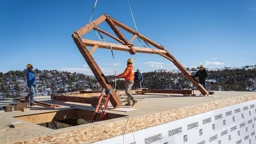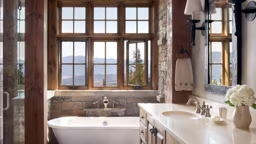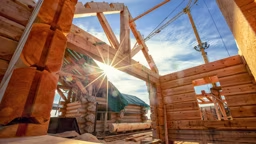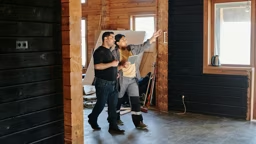
In “Romeo and Juliet,” William Shakespeare penned the classic line, “What’s in a name? That which we call a rose by any other name would smell just as sweet.” It’s a phrase that even people who haven’t studied The Bard are familiar with, and it implies that it doesn’t matter what words we use to identify an object — the thing remains the same.
While that may be true in theory, in order to get exactly what you want in a custom home, it’s essential to know the correct building terms, the specific style types and the proper names for materials. If you can’t accurately convey your wants and needs to your design/build team, the outcome could be less than desirable. But if you’re employing a specialized construction method like timber framing, the results could be disastrous.
A timber home uses a framework of large posts and beams joined by wood pegs or other types of fasteners. Almost always, the walls of the structure are affixed to the outside of the timber frame, leaving the timbers exposed for visual effect and, save the doors and windows, create a nearly uninterrupted enclosure. This makes the house very energy efficient.
A big advantage of this method is that it’s so strong it doesn’t require load-bearing walls cutting through the center of the house. You can arrange the floor plan in any configuration you choose, including a totally open great room/dining room/kitchen — a layout that’s highly sought after by today’s home buyers.
Outside, the home can be clad in an endless array of materials, so your timber home can look like any style of house you choose. And it can fit in anywhere — even subdivisions with stringent design parameters — making timber framing an ideal choice for anyone who wants a personalized and very special place to call home.
The Timber Difference
There’s another reason schooling yourself on the specifics of timber talk is important — timber framing isn’t exactly a household word. Even though the general public is repeatedly exposed to timber frame construction via commercials, catalogs, movie sets and more; these homes are often misidentified as log houses, because of their exposed wood elements.
Make no mistake — timber frame homes are not log houses. They are different and specific methods of construction. In both cases, the wood members structurally support the house, but the main distinction between log and timber homes is how they use that wood.
As a rule, log homes stack their wood members horizontally; timber homes employ a system of vertical posts connected by horizontal beams. Not only do these building techniques cause the structures to carry the load (weight) of a home in dissimilar ways, they achieve sharply different looks. And because timber homes use a variety of exterior finishing materials having nothing to do with the wood inside, they may not be recognizable as timber frames, whereas log homes are always easily spotted from the curb.
Benefits Beyond Beauty
Beyond the aesthetics of exposed wood and open floor plans, timber structures enjoy a durability that conventionally built homes just can’t touch. They also provide more structural integrity in the unfortunate event of a fire, as the large timber supports are more resistant to burning completely through than the thinner 2-by-4s or 2-by-6s that comprise stick-built structures.
They also take the lead in terms of energy efficiency. A timber home’s frame (also often referred to as its “skeleton”) is usually wrapped in a panelized building component called “structural insulated panels,” which creates a nearly uninterrupted blanket of insulation that can result in a 35 percent reduction (or greater) in energy costs over stick-framed construction.
A timber home also affords its owner the opportunity to make a bold design statement, as timbers come in a variety of wood species, thicknesses and styles — especially when it comes to truss systems. A timber home can take on an ornate Victorian style, the more restrained feel of a classic cottage or a contemporary mountain-modern motif.
Talking Timber Terms
Confucius says: “The beginning of wisdom is to call things by their proper names.” Timber framing has a language all its own, and below is a brief list of commonly used timber frame terms to help you better understand its main components.
- Posts. The vertical members.
- Beams. The horizontal members.
- Truss. A rigid triangle of timbers. Trusses provide column-free floor space and are incorporated at ceiling height.
- Bents. Created when the vertical and horizontal components are joined together with the trusses. Bents form the cross-section of a timber frame and enable it to carry the structural load.
- Joints. Where two timbers or frame pieces come together. Joints can range from simple to highly decorative and include lap joints, mortise-and-tenon joints, dovetailed joints, pegged joints and others.
- Brace. Short, diagonally positioned timber supports used as reinforcement in the corners of a frame to prevent horizontal shear.
- Rafters. Roof-support timbers that extend upward, from the wall plate to the topmost ridge beam, are called rafters. Rafters and purlins are sometimes used in combination. Principal rafters form the sloping gable roofline on each bent.
- Trunnels. A wood dowel or peg used as a fastener. Depending on the builder or owner’s prerogatives, the exposed pegs are either cut off flat to the face of the timbers or remain uncut for a more rustic look.
- Mortise & Tenon. A male end (tenon) cut onto the end of one timber that fits into a square-cut matching female receptacle (mortise).
- SIPs. The most popular way to sheathe a timber structure. Made of two layers of durable plywood sandwiching a dense insulating core, SIPs have revolutionized residential insulation by creating a nearly uninterrupted enclosure with high thermal performance.
- Hybrids. Timber framing is so versatile, it can be combined with other types of construction, such as conventional stick-frame building, log construction and others, creating what’s known as a hybrid. Combining building systems may save money and will add visual interest to a home.











